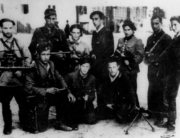Welcome to the surreal, macho, and denial filled world of narcocorridos. This popular and controversial musical style is inspired by the drama of narco-traffickers and their violent fueled pathway out of poverty.
Narco Cultura illuminates the inherent and numerous ethical dilemmas of this musical genre by opening with footage of the stark differences on both sides of the border between Juárez, Mexico, and El Paso, Texas. Through the next 102 incomparable minutes, it continues to provide opportunities to understand these interconnected yet disparate worlds.
This difficult but essential to watch film will blow your mind.
Richi Soto is a crime scene investigator in Juárez. In 2007, he and his colleagues were faced with 320 murders. “Then the drug wars came,” says Soto. In 2010, he “processed” 3,622 murders. Ninety-seven percent of this evidence has not been investigated, and no one has been brought to justice. Meanwhile, three of Soto’s colleagues have been murdered and others have quit. Soto and others wear masks as they do their work, avoid going out of their homes, and are constantly on alert.
El Paso Texas, just across the border, is the safest city in America with only five murders per year, according to the film.
In Los Angeles, Edgar Quintero is a 27-year-old lead narcocorrido singer and member of the band BuKnas de Culiacán. He receives commissions in the form of large wads of 100 bills plus lyric tips about guns and drugs—he’s happy to oblige immortalizing and glamorizing his gangster clients by creating theme songs for them. Ever since escaping from a high-security Mexican prison 12 years ago, “El Chapo” Guzmán has become one of the most elusive and famous criminals in modern times. He’s also the richest, and Quintero’s hero and muse.
In Juárez, we see Soto “processing” bodies, the result of Guzman’s legacy. We see shop keepers trying to wash away a river of blood off the street. A mother, whose son was decapitated and cut up into 16 pieces, cries and pleads for something to be done, while those in the background turn away and hide their faces.
We see Quintero at home and traveling throughout America, performing in front of sold-out crowds, parading with Bazookas and other weapons, and his fans singing along with him enthusiastically. At home with his family—wife, two-year-old son, and 10-month-old daughter—he changes diapers and pushes his son in a stroller, singing, “We’re bloodthirsty and crazy and we like to kill,” and his son says, “AK-47!”
Soto’s girlfriend wants to move to El Paso, where it’s safer and quieter. Meanwhile, Quintero wants to live over in Mexico—“just to get the feel of life over there, help my career, help my songs.” When his wife looks disbelievingly at him, he says, “maybe a six-month vacation. It’s been the strongest cartel and is important to the corridos [songs].”
We travel from the funeral of the fourth investigator on Soto’s team, buried among a sea of white wooden crosses in a dilapidated cemetery, to Quintero’s trip to Culiacán, Sinalao—the capital of the drug wars and the inspired name of his band. Here he visits a meth farm, swaggers around drinking beer, smoking dope, and shooting his gun in the air.
The film is worth watching just for the Jardines del Humaya cemetery (seen in the documentary El Velador). In a neatly landscaped and ever expanding neighborhood of paved streets and trees that could be in Beverly Hills, the dead are buried with their trucks in huge mausoleums, resembling the richest of mansions, some with bulletproof glass.
Filmmaker Shaul Schwarz was a war photographer documenting the drug violence in Mexico for many years. His images illuminate both explicitly and implicitly what is happening. A must-see for adults, this film would be amazing and important to share with young people in the hopes they would see the intersections between the reality of violence and the glorification of it. The film is ripe for curriculum development and discussions about the drug wars, the politics of the border area, how people deceive themselves and others, and what happens when people are without hope.
Bling: Blood, Diamonds and Hip Hop, where former child soldier Ishmael Beah takes hip-hop artists on a trip to see the reality of blood diamonds, barely touches the surface of Narco. Indeed, in Bling, most of the hip-hop artists have their eyes opened to their ignorance. Not so with Quintero, who has no such awakening. He continues to sell his records and tour the U.S. in spite of his music and others like it being banned in Mexico.







Leave A Comment